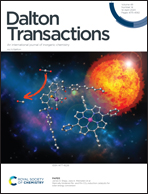Fabrication of a multifunctional magnetic-fluorescent material for medical applications†
Abstract
Multifunctional biocompatible materials have evoked considerable interest in the field of medical applications. Here we report the thermal decomposition preparation of homogeneous fluorescent-magnetic particles with a composite structure containing CoFe2O4 nanoparticles as nucleation seeds for fluorescent Gd2−xO3:Eux. The composite exhibited a wide range of fluorescence transitions in the whole visible spectrum, displaying 18 different emission peaks when excited at a 250 nm wavelength. Moreover, at low temperature the peaks of the composite were wider than the peaks of the fluorescent material, which may be attributed to a set of new energy levels due to a combination of Stark splitting with the magnetic field of CoFe2O4. Because this material is intended to be used for biomedical applications, the potential toxicity of the composite was tested using an invertebrate hemocyte cell model. The cells showed slight morphological and biochemical changes upon exposure to the composite; however, there was no increase in cell death at concentrations of up to 40 ppm. In addition, the material could be tracked by its fluorescence inside the cells, when excited at a more bio-friendly and less energetic wavelength of 405 nm. Furthermore, MRI showed T1 and T2 dual contrast with relaxivity values in the range of most reported materials.

- This article is part of the themed collection: Celebrating recent chemical science in Mexico


 Please wait while we load your content...
Please wait while we load your content...